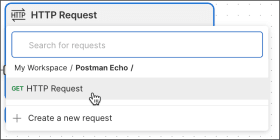Create Postman requests and variables using Postman Flow blocks
You can send API requests and receive responses in your flows with the HTTP Request block. Your flow can then evaluate and transform the response data to inform its logic, make decisions, and pass relevant information to other blocks.
API requests often use different data each time they’re sent. For example, a request to a weather API might specify a different city each time. In Postman, you can use variables to manage interactions with APIs that expect or respond with data that changes from request to request.
To learn how to create a request in a flow, check out this Postman Flows tutorial.
Requests
With the HTTP Request block, you can select an existing request from a collection in your workspace, or create a new request.

If the workspace contains no collections, you can get started by choosing from the suggested requests that appear under the Spotlight heading.
Postman Flows can run requests that use files in your local working directory to send body data. To make collaboration and publishing your flow easier, upload your test data files to your Postman team.
You can run requests with scripts that import packages from your team’s Postman Package Library. Learn how to add packages to the package library, and import packages into your scripts. You can also run collections that import external packages from npm or JSR package registries.
Variables
Variables are values that can change from one request to another. These can be things like IDs, usernames, and numbers.
The variables part of the HTTP Request block opens automatically and enables you to enter values.
In this request, the variable is named “method” and its value is the string “GET”. (For more information on setting up variables in requests, see Store and reuse values using variables.) Once the request runs, you can preview the response by selecting the Success output port. The response body includes the request’s URL, which uses a GET method defined by the variable.
Last modified: 2025/03/19